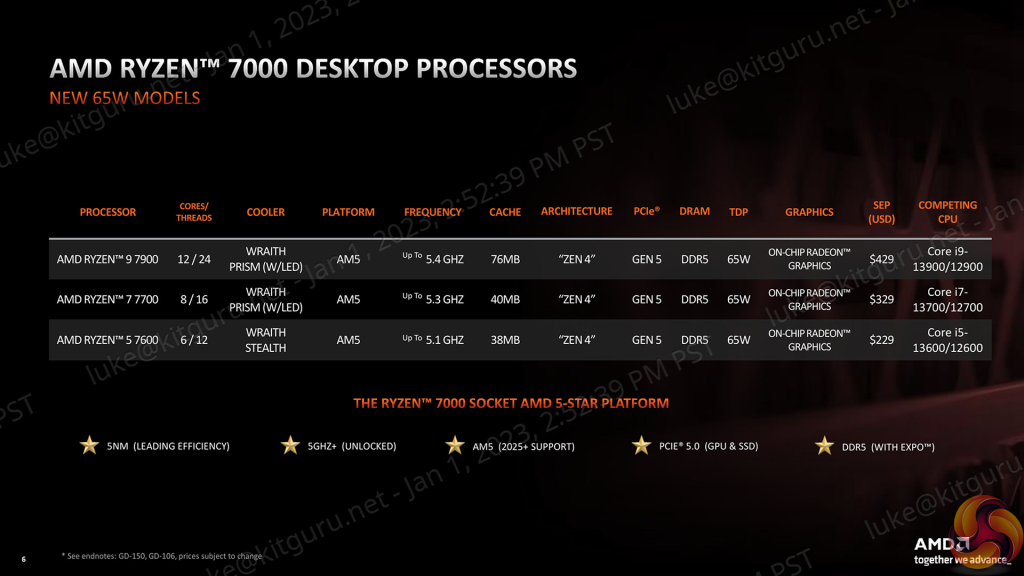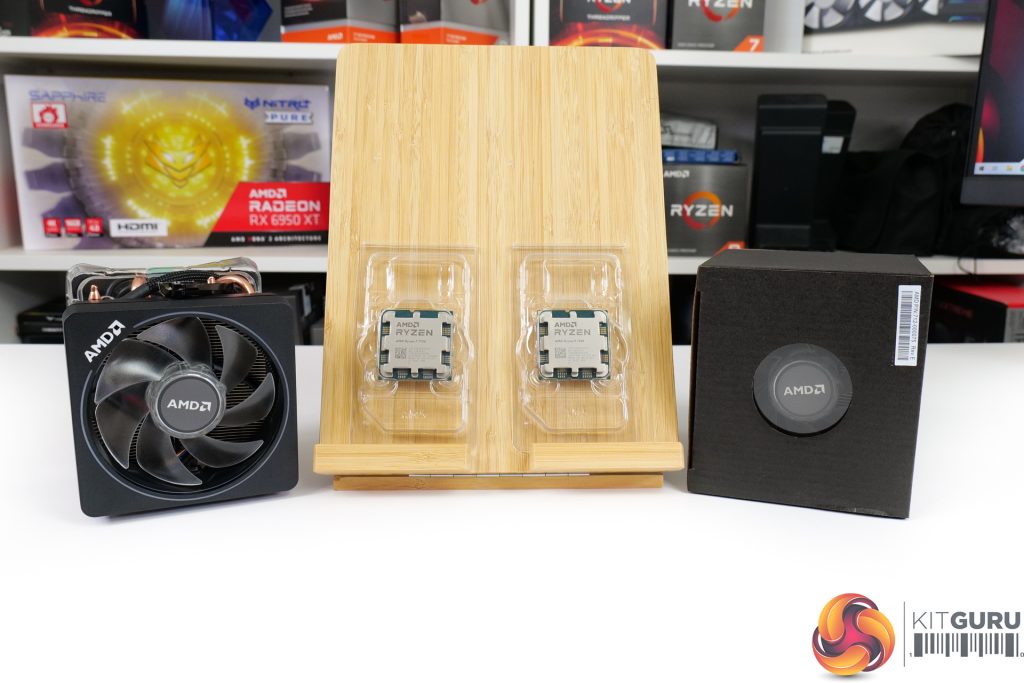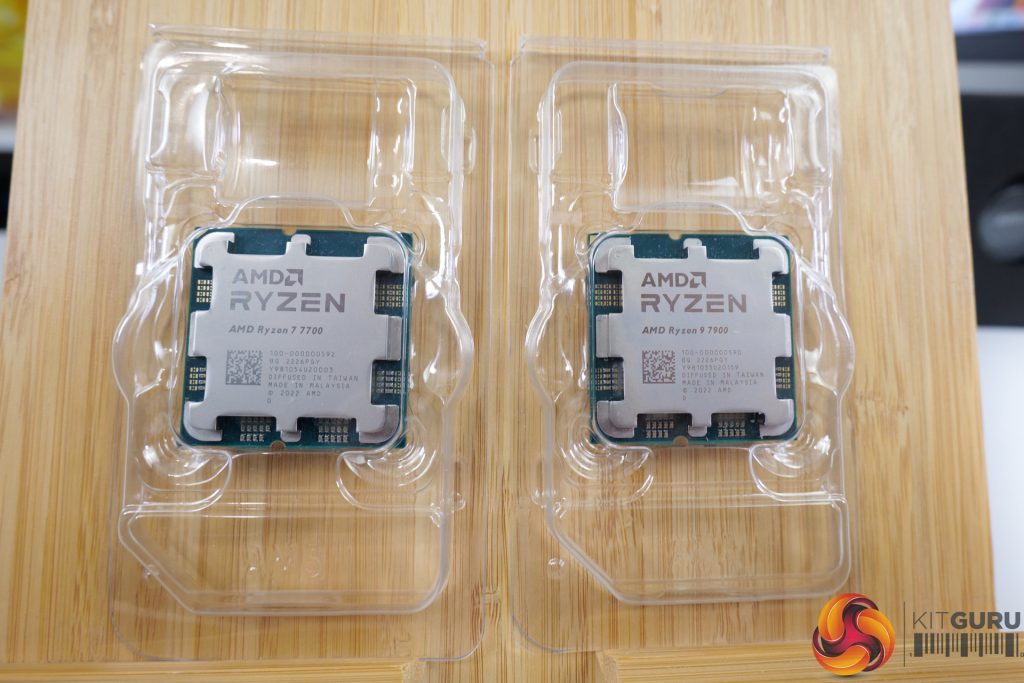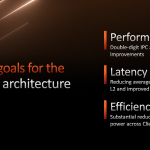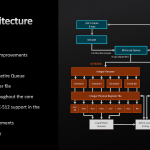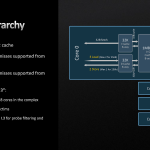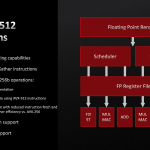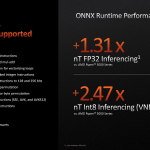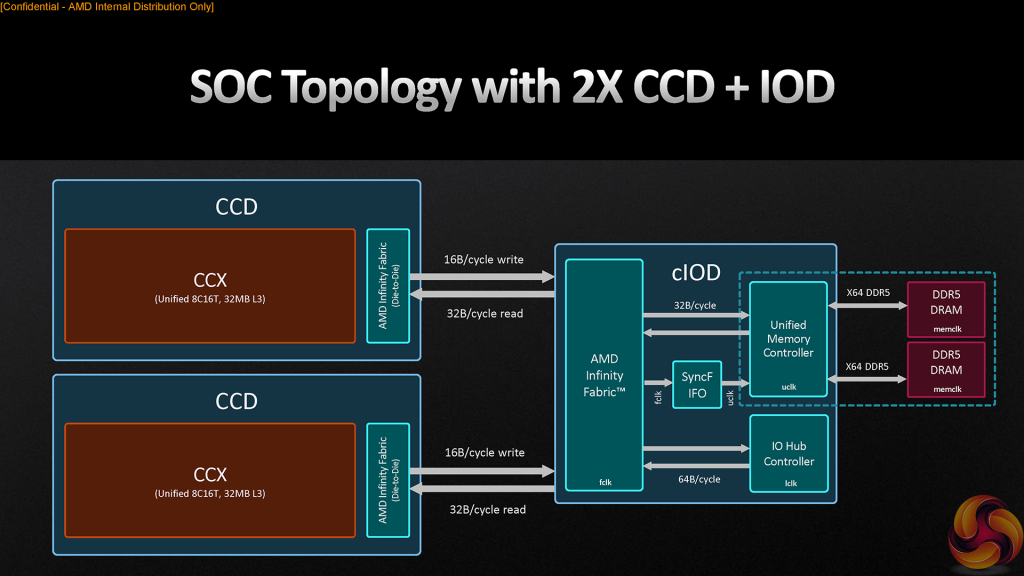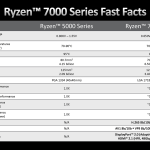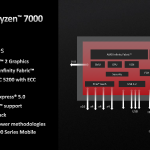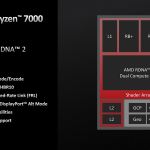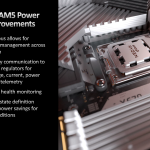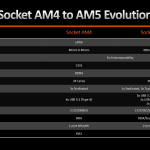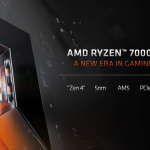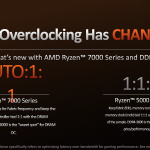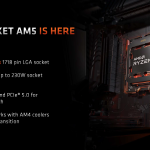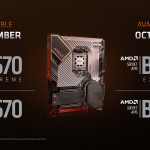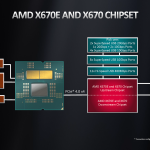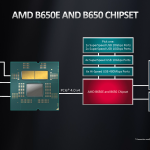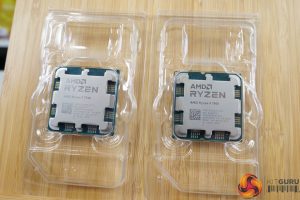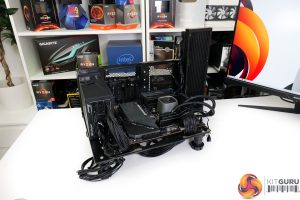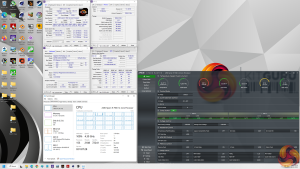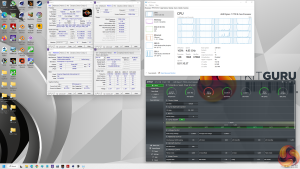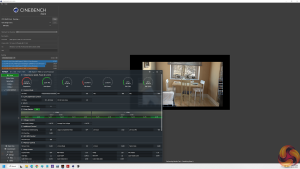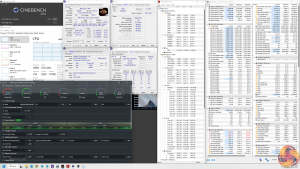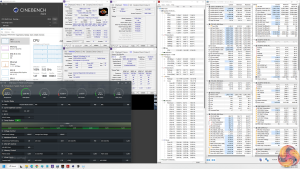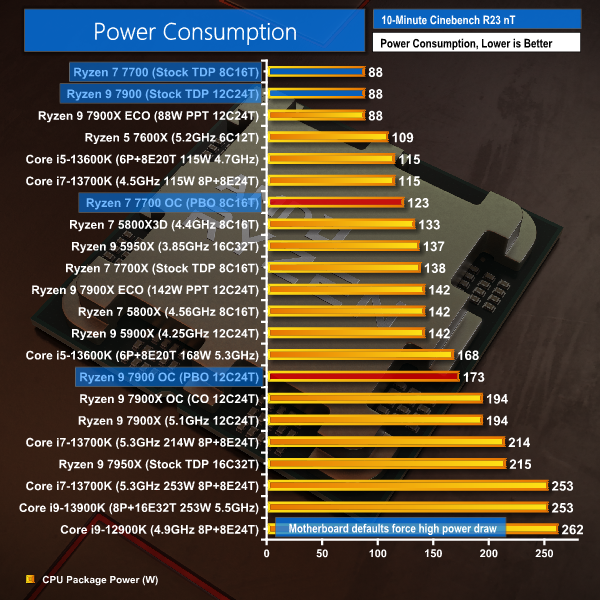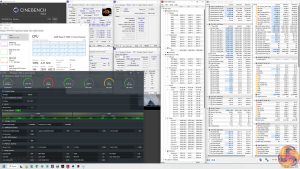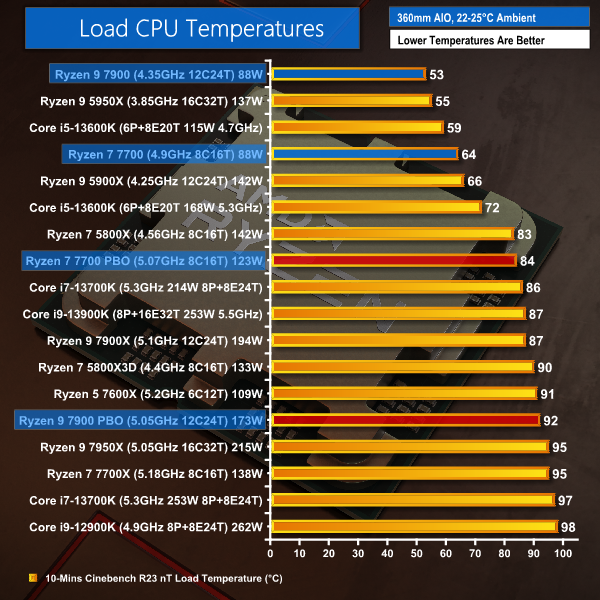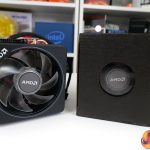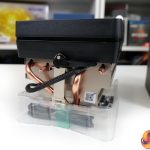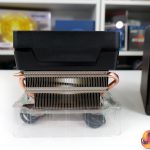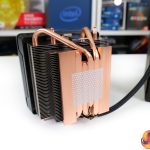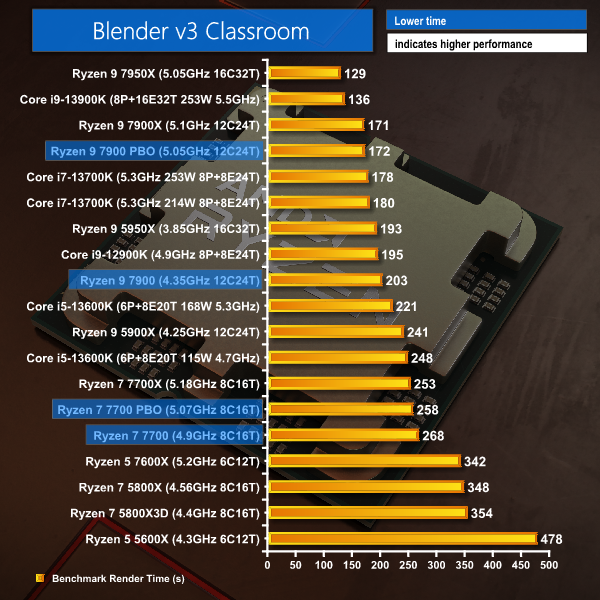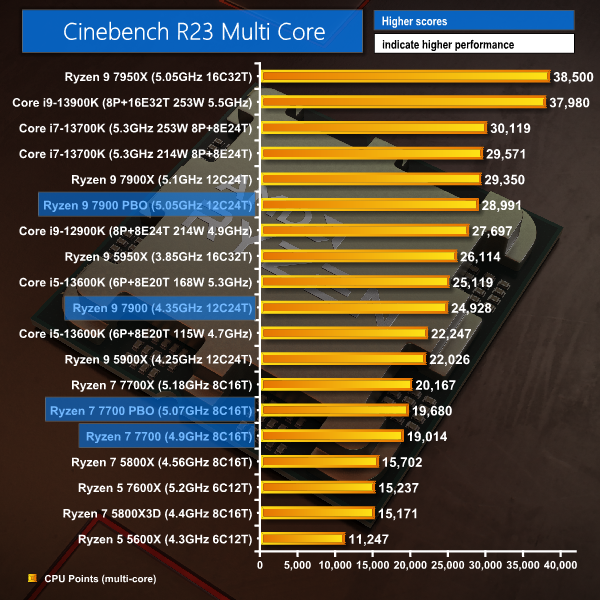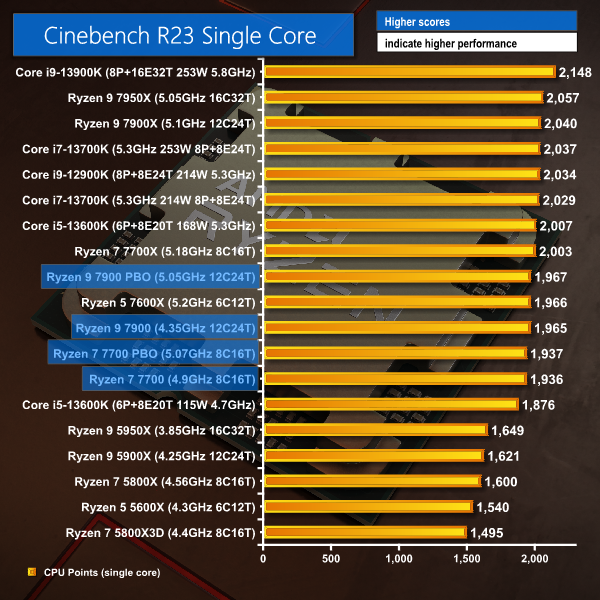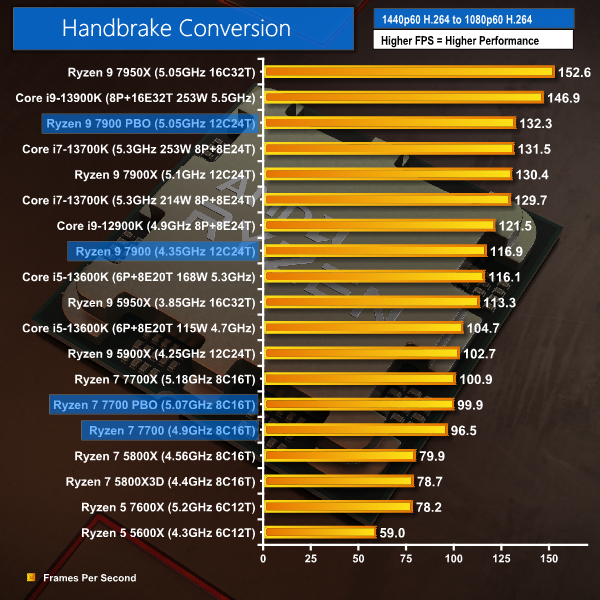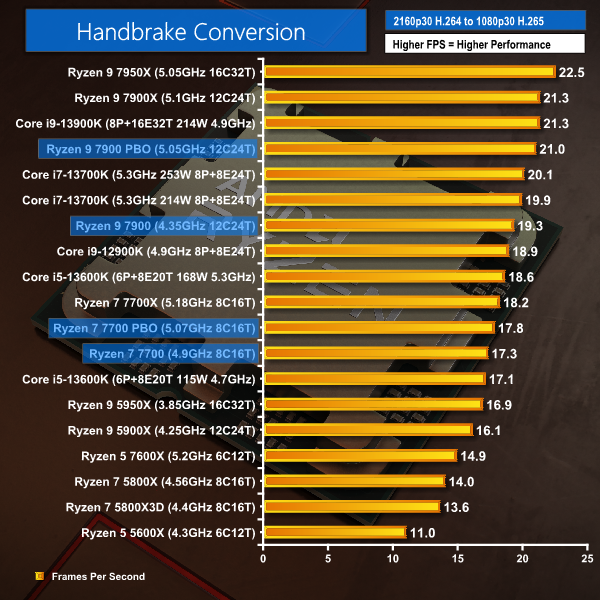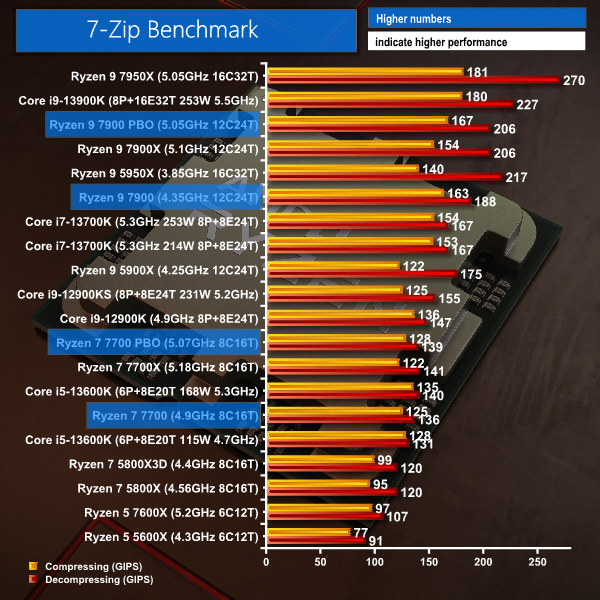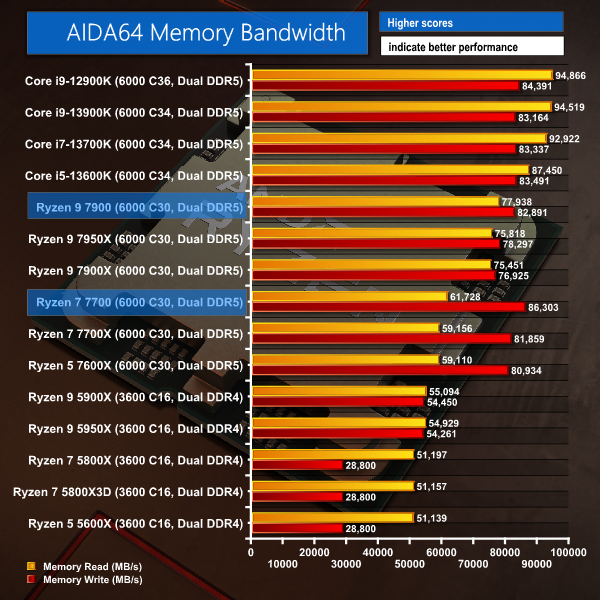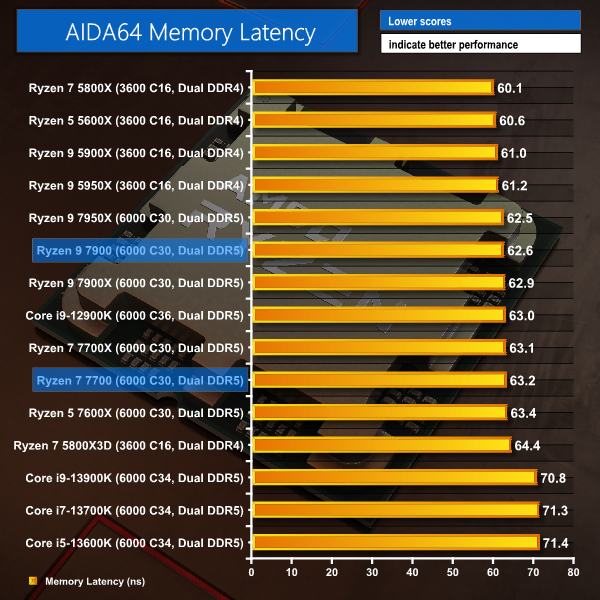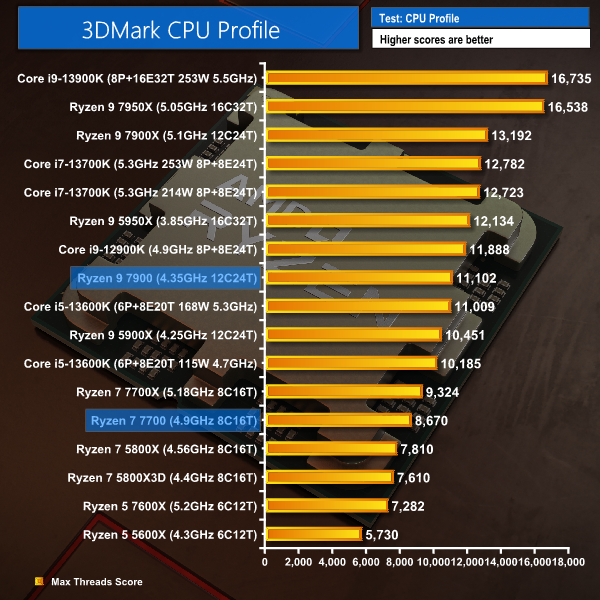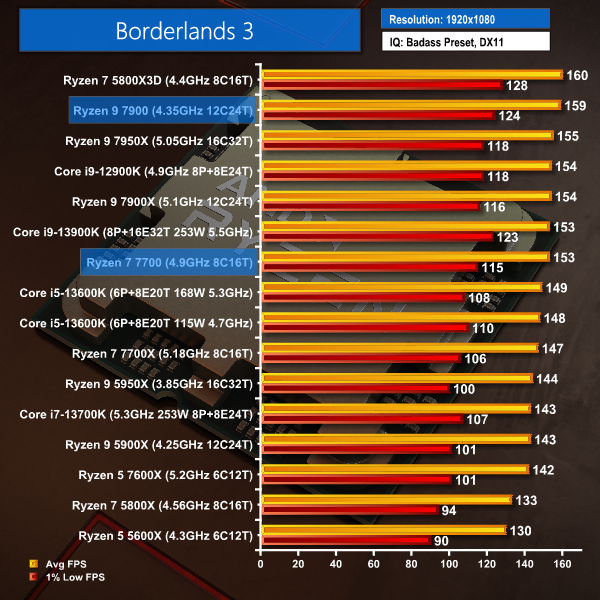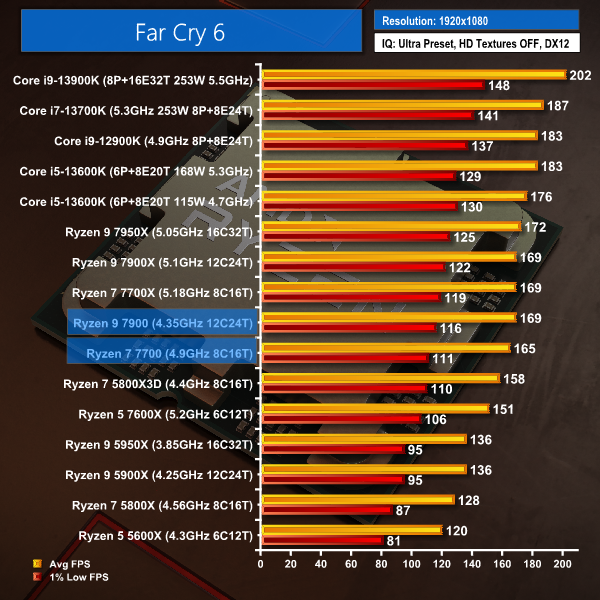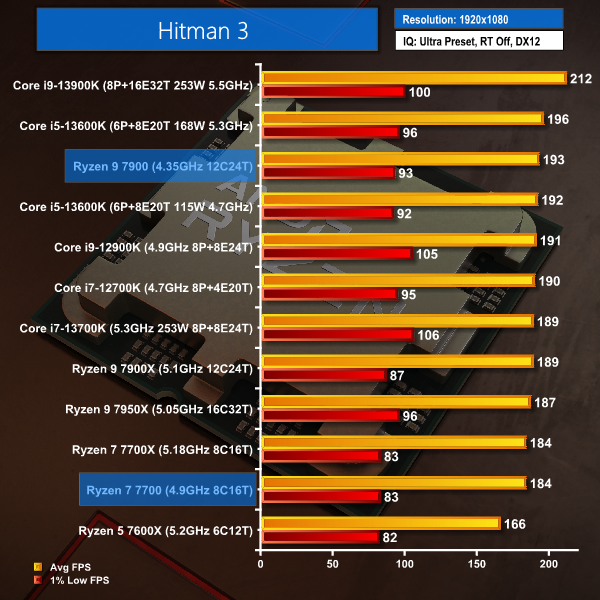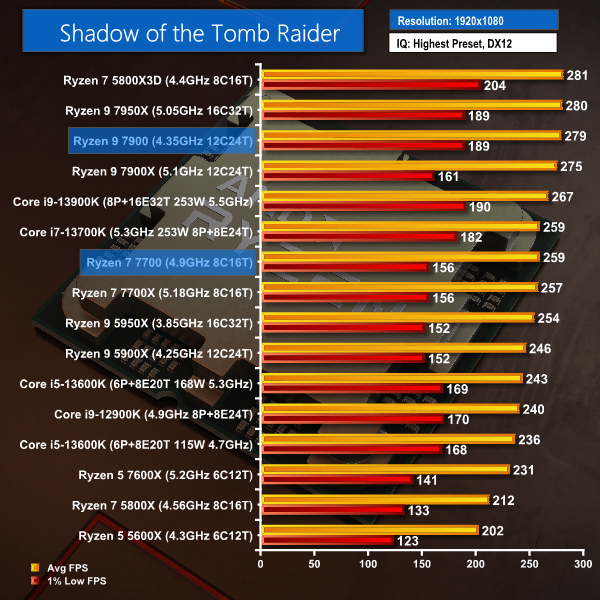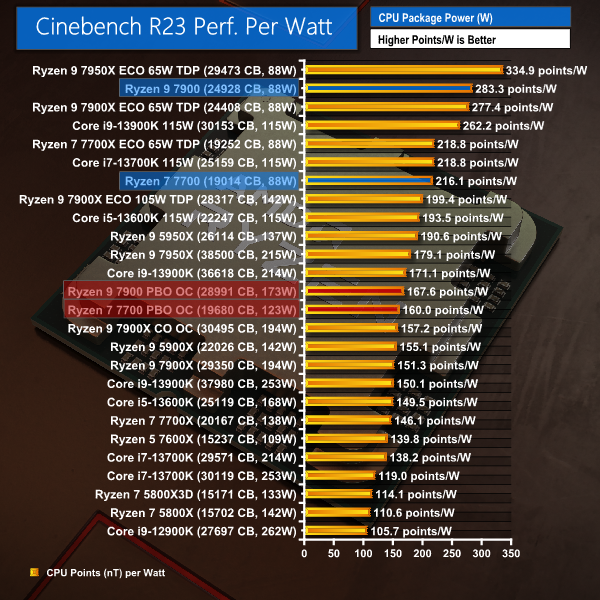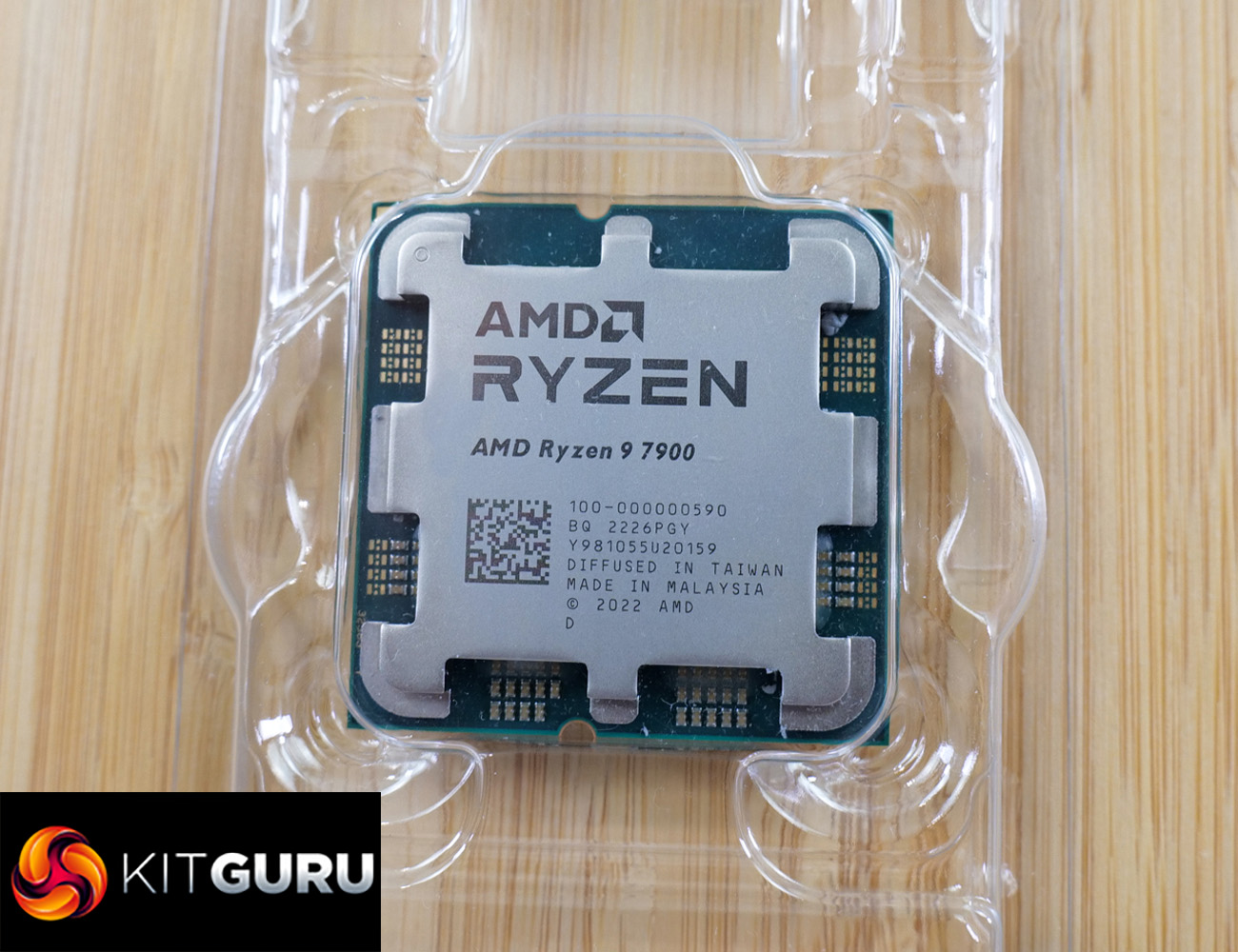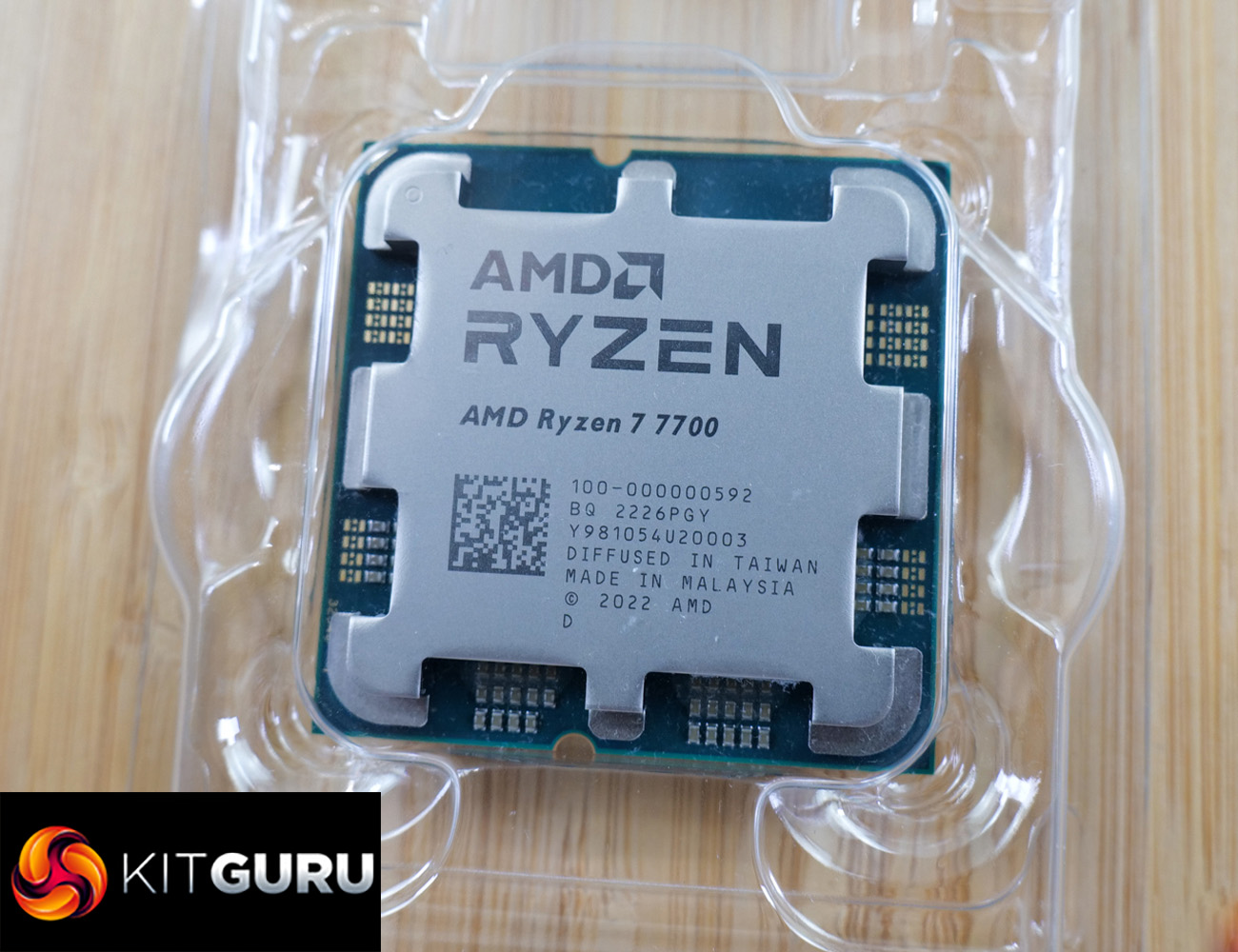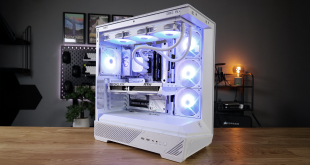AMD’s Zen 4-based Ryzen 7000 series processors were introduced with a positive reception when they launched back in September 2022. Performance was strong, frequency was impressive, and the overall platform features were very user friendly. With that said, it wasn’t all plain sailing. The 170W TDP Ryzen chips guzzled power and they ran at lofty temperatures – often hitting 95C. And the story wasn’t too dissimilar for the 105W TDP Ryzen 7 and Ryzen 5, either.
With those points in mind – as well as the proven excellent performance even at lower power levels – AMD has made the decision to release 65W TDP non-X chips in the form of Ryzen 9 7900, Ryzen 7 7700, and Ryzen 5 7600.
Other than the reduced TDP and therefore operating frequencies, these non-X chips are practically the same as their X-rated siblings.
It’s the same TSMC 5nm process, the same 32MB of L3 cache per core chiplet, and the same IO Die with PCIe Gen 5, DDR5, and RDNA 2 iGPU support.
AMD does, however, include a Wraith Prism cooler with the Ryzen 9 and Ryzen 7 and the Wraith Stealth for the Ryzen 5.
MSRP is $429 USD for the Ryzen 9 7900, $329 USD for the Ryzen 7 7700, and $229 USD for the Ryzen 5 7600. Those price seem pretty reasonable given the current retail market competition.
Pricing in the UK, however, is different. The Ryzen 9 7900 is £439.99, the Ryzen 7 7700 is £339.99, and the Ryzen 5 7600 is £239.99. Even by the usual dollar-to-pound standards, that is a very poor conversion for us Brits.
I guess the weak pound and strong dollar really does not help.
Will those price points and the inclusion of a Wraith CPU cooler make the non-X chips a tempting proposition? Let’s look at the performance and find out.
Zen 4 architecture
Let’s start out with a quick overview of the new Zen 4 architecture.
We have already written several article on Zen 4 – including an announcement piece from August 2022 as well as the launch Ryzen 7000 review HERE. So, make sure you check out the previous content for more details.
According to AMD, the key design goals for the Zen 4 architecture focused on efficiency gains, latency improvements, and better performance in terms of frequency and IPC.
Changes to the cache structure allow AMD to enhance the data flow and reduce latency. One key area to this point is the doubling of L2 cache capacity to 1MB per core instead of 0.5MB per core on Zen 3.
Front-end, execution engine, and load/store advances are achieved via various measures. The enhancements are designed to improve the data flow for the new Zen 4 core versus Zen 3. And that’s particularly useful for better utilising the downstream resources whilst also reducing latency in the underlying architecture, particularly with that larger slice of L2 cache.
Another noteworthy enhancement to Zen 4 is AVX-512 support. This is technically handled via a double-pumping of the 256-bit wide data path, rather than a single operation, because AMD didn’t want to spend the core area of a full 512-bit data path.
While AVX-512 support is a cool inclusion, we have seen from Intel’s adjustments that it isn’t really a significant benefit for the consumer market currently. Zen 4 servers on the other hand – they’ll like that alongside BFloat16.
Ryzen 7000 CPU Configuration
The Ryzen 7000 chips use 8-core CCXs built on the TSMC 5nm process node.
The individual Core Complexes feature a 32MB slice of L3 cache – as we saw with Zen 3 – but no 3D V-Cache like we saw with the 5800X3D.
Each 8-core core chiplet measures in at 70mm2 with 6.50 billion transistors. That’s an area reduction versus the 80.7mm2 Zen 3 core chiplet which featured 4.15 billion transistors. Clearly, the density uptick of TSMC 5nm is substantial.
Aside from density, frequency is another huge improvement from 5nm. We now see boost clocks as high as 5.7GHz on the 16 core chip!
The new Ryzen 7000 Series IO Die is a substantial improvement versus Ryzen 5000.
Fabbed on the TSMC 6nm process node, AMD has gone for a more advanced, more expensive manufacturing option with its Ryzen 7000 IO Die. That’s actually a change of direction versus Ryzen 5000 that was built using significantly older 12nm process technology.
This decision allows AMD to increase the transistor count from 2.09 Billion previously to 3.40 Billion now, alongside a small decrease in die area from 125mm2 on Ryzen 5000 to 122mm2 now. And they jam a bunch more functionality onto the new IO chiplet, too.
We get 28 lanes of PCIe Gen 5, a dual-channel DDR5 memory controller that supports up to JEDEC-5200 and ECC, USB 3.2 and Type-C support, and USB BIOS Flashback.
AMD also includes low-power methodologies borrowed from the Ryzen 6000 Series Mobile processors, such as SOC power states, clock gating, and power gating.
Importantly, the IO Die also features the integrated GPU that features two RDNA 2 Compute Units.
When we asked AMD about this inclusion during their tech day in Austin, Texas, the response was quite clear in that this was included to allow them to sell partner systems to businesses who require iGPU capabilities for powering a basic monitor.
As we have seen on the Intel side, though, the inclusion of a modern iGPU also has the benefit of allowing for competent media encode and decode capability
Of course, it’s not just the new Ryzen 7000 series processors that have launched recently, as the new chips sit on AMD’s new AM5 platform
The new 1718 pin LGA AM5 socket features a denser pin array for better power capability and improved signal integrity for high-speed interfaces like DDR5 and PCIe Gen 5.
Now, we see chips with TDPs up to 170W out of the box, which means 230W of package power delivered under stock conditions. That’s a substantial uptick versus the 142W peak package power delivery for stock AM4 chips.
AM5 package size is the same 40mm x 40mm as AM4. AMD could have done with a bigger area to work with but decided that a instead unique heatspreader design to permit CPU cooler backwards compatibility was a worthwhile compromise.
The new platform also gets some improved sensor data feed through for power and temperatures. This should improve operations in some domains versus previous Ryzen chips.
AMD's AM5 supports DDR5, and DDR5 only.
AMD wasn’t interested in adding DDR4 support, as Intel does. This was because they’d rather drag the market towards the transitioning to DDR5 instead of supporting the older memory technology. And that’s because the bandwidth and throughput improvements of DDR5 are very much essential to AMD’s platform design.
There is technically ECC support for memory, but this will depend upon motherboard vendor implementation.
As far as frequencies go, AMD support up to 5200MHz JEDEC by default.
Of course, actually usable speeds are high. AMD is suggesting that the new memory sweet spot is DDR5 6000MHz with tight latencies in 2x16GB form. And it is doubling-down on this point by partnering with memory vendors to implement EXPO – which is essentially the AMD alternative to XMP that the company believes is more open and better suited for the AMD platform.
A critical adjustment on the memory subsystem is the decoupling of the Infinity Fabric clock and the Memory Controller clock.
With previous Zen, memory clocks above 3600MHz would result in a divider being applied to the Infinity Fabric clock, thus reducing its effective speed and imparting a significant latency penalty. Now, the Infinity Fabric clock is no longer linked with the memory controller clock.
This means that the Infinity Fabric is generally maintained at 2000MHz while the memory controller runs at 2400MHz for DDR5-4800 or 2600MHz for DDR5-5200 or 3000MHz for DDR5-6000.
Above 6000MHz RAM speed and the memory controller will run at a 2:1 divider. So, 6000MHz is a sweet spot, while DDR5-6200 and 6400 kits realistically sit in the valley of death whereby the slower memory controller will impart a latency penalty. But Infinity Fabric is decoupled so it will stay at 2000MHz frequency, thus the latency penalty is kept to the memory subsystem specifically, and not the processor and platform side of the equation.
TL;DR – AMD reckons that DDR5-6000MHz with nice timings and EXPO configuration is a smart sweet spot. And we’ll test this out some more over the coming weeks and months.
28 lanes of PCIe Gen 5 connectivity are positioned on the new Ryzen 7000 Series processors.
Realistically, this splits out as 24 lanes usable and 4 lanes for connection between the CPU and chipset. AMD increased the count to 24 lanes usable on AM5 versus 20 lanes previously to allow for more CPU-linked storage capacity.
Actual PCIe Gen 5 platform support is convoluted, though.
X670E and B650E motherboards allow PCIe Gen 5 on expansion slots (graphics cards) and M.2 storage interfaces. Whereas X670 and B650 non-E motherboards will limit Gen 5 to only the storage connections. Though this may vary as AMD said it isn’t mandated to the motherboard vendors.
With regards to chipsets, we currently have X670E, X670, B650E, and B650. The ‘E’ suffix denotes enhanced Gen 5 connectivity or (generally) Gen 5 limited to some storage interfaces.
AMD’s processors have four PCIe lanes reserved for linking with the motherboard chipset. However, this link runs at PCIe Gen 4×4 bandwidth instead of Gen 5. AMD told us that a Gen 4×4 is ample given the likely downstream bandwidth requirements, as well as enhanced CPU-direct storage allowances.
The X-series and B-series chipsets differ by their quantity of connection interfaces. But AMD makes a point in highlighting that there are no artificial limitations like overclocking capability or reduced memory frequencies. Realistically, a motherboard vendor could make a B650E motherboard that’s just as good as an X670E option, bar fewer connectivity interfaces.
And those connectivity interfaces that we get through the chipset include PCIe Gen 4 links for storage and expansion cards, flexible SATA 6Gbps connections, and USB interfaces up to 20Gbps. Exactly what is included will vary from vendor to vendor.
The X-series chipset uses a dual-chiplet approach to offer its enhanced connectivity options. These chiplets are daisy-chained, so there could be some bandwidth headaches in some niche – workstation-calibre – use cases, despite AMD’s assurances that these would be unlikely (and they almost certainly will be).
We will be pitting the new 65W TDP Ryzen 7000 series non-X chips against their logical Ryzen 7000, Ryzen 5000 and Intel 12th and 13th Gen competitors.
The AM4-based Ryzen 5000 processors will be coupled with 32GB of dual-rank DDR4 3600MHz C16 memory. Both DDR5 platforms use 32GB 6000MHz sets from G.SKILL’s Trident Z5 range. Though the timings differ slightly, with the AMD EXPO kit running at 30-38-38-96 versus the Intel XMP set at 36-36-36-96. This is pretty close between the two sets.
The new AMD processors are tested on Gigabyte’s X670E Aorus Master motherboard featuring the BIOS revision and AGESA profile as supplied and validated by AMD.
Each processor is tested at its default out-of-the-box settings. For the Intel CPUs, turbo limits as set by the motherboard with XMP enabled is the operating mode. All-core load frequencies for the tested chips are as follows:
- Core i5-12600K = 4.5GHz on the P-cores.
- Core i7-12700K = 4.7GHz on the P-cores.
- Core i9-12900K = 4.9GHz on the P-cores.
- Core i5-13600K (168W) = 5.3GHz on the P-cores.
- Core i7-13700K (253W) = 5.3GHz P-cores.
- Core i9-13900K (253W) = 5.5GHz on the P-cores.
- Ryzen 5 5600X = around 4.3GHz.
- Ryzen 7 5800X = around 4.56GHz.
- Ryzen 7 5800X3D = around 4.4GHz.
- Ryzen 9 5900X = around 4.25GHz.
- Ryzen 9 5950X = around 3.85GHz.
- Ryzen 5 7600X = around 5.2GHz.
- Ryzen 7 7700X = around 5.18GHz.
- Ryzen 9 7900X = around 5.1GHz.
- Ryzen 9 7950X = around 5.05GHz.
CPU Test System Components:
- AM5 Motherboard: Gigabyte X670E Aorus Master
- AM5 DDR5 Memory: 32GB (2x16GB) G.SKILL Trident Z5 Neo 6000MHz 30-38-38-96 DDR5
- Dedicated Graphics Card: Sapphire Nitro+ Pure Radeon RX 6950 XT
- CPU Cooler: 360mm AIO liquid cooler
- Power Supply: Seasonic Prime TX-1600
- Operating System: Windows 11 Pro
- Z790 Motherboard: Asus ROG Maximus Z790 Hero
- Z790 DDR5 Memory: 32GB (2x16GB single-rank) G.SKILL Trident Z5 RGB 6000MHz
- AM4 Motherboard: Gigabyte X570S Aorus Master
- AM4 DDR4 Memory: 32GB (2x16GB dual-rank) Corsair Vengeance LPX 3600MHz 16-18-18-36 DDR4 @ 1.35V
- Z690 Motherboard: ASUS ROG STRIX Z690-F Gaming WiFi
- Z690 DDR5 Memory: 32GB (2x16GB single-rank) G.SKILL Trident Z5 RGB 6000MHz 36-36-36-96
Tests:
Productivity-related and Synthetic:
- Cinebench R23 – All-core & single-core CPU benchmark (CPU)
- Blender 3.3.0 – All-core rendering of the Classroom benchmark (CPU)
- HandBrake 1.5.1 H264 – Convert 1440p60 H264 video to 1080p60 H264 using the YouTube HQ 1080p60 preset (CPU)
- HandBrake 1.5.1 H265 – Convert 4K30 100Mbps H264 video to 1080p30 40Mbps H265 using the H.265 MKV 1080p30 preset (CPU & Memory)
- 7-Zip v22 – Built-in 7-Zip benchmark test (CPU & Memory)
- SiSoft Sandra – Memory bandwidth and Cache bandwidth/latency tests (Memory)
- AIDA64 – Memory bandwidth & memory latency (Memory)
- 3DMark – Time Spy and CPU Profile Benchmarks (Synthetic Gaming)
Gaming-related:
- Borderlands 3 – 1920 x 1080, Badass quality preset, DX11
- Far Cry 6 – 1920 x 1080, Ultra quality preset, HD textures OFF, DX12
- Hitman 3 – 1920 x 1080, Ultra quality preset, RT OFF, DX12
- Shadow of the Tomb Raider – 1920 x 1080, Highest quality preset, no AA, DX12
Starting out with a look at operating frequencies, this is where we see obvious deficits for these non-X processors versus their higher-powered X siblings.
The Ryzen 9 7900 runs at around 4.35GHz all-core under a Cinebench workload. The stock Ryzen 9 7900X, by comparison, was pushing 5.1GHz.
The Ryzen 7 7700 runs at around 4.9GHz all-core in Cinebench. This is around 250-300MHz slower than the Ryzen 7 7700X.
For overclocking, I ran Curve Optimiser, but this resulted in a frequency setting that was unstable for 7-Zip and Handbrake. Instead, I reverted to relying upon AMD’s good old Precision Boost 2 algorithm and leveraging Precision Boost Overdrive.
This one-click overclock is ideal for the 65W TDP chips as it allows extra power budget to be pushed their way, and the higher frequencies that come with that.
The Ryzen 9 7900 ran at 5.05GHz under its PBO all-core load. This is only 50MHz slower than the stock Ryzen 9 7900X.
The Ryzen 7 7700 measured in at 5.07GHz all-core, which is just over 100MHz slower than the default Ryzen 7 7700X. In short, PBO looks to be an excellent way of pushing these cheaper processors to similar frequencies as their X-rated sibling.
For CPU load results, we read the power draw after running 10 minutes of the Cinebench R23 nT all-core rendering test. The same test parameters are used for temperature readings.
The power consumption of our entire test system (at the wall) is shown in the chart. We also include the reported CPU Package Power.
Power Consumption
Power draw readings are accurate to around +/-5W under heavy load due to instantaneous fluctuations in the value.
Looking at power consumption, the new 65W TDP Ryzen 7000 chips are excellent. 65W TDP in the AMD design translates into 88W of allowable package power.
This is an incredibly low power draw number by modern standards, and it makes the non-X parts PSU-friendly by even Ryzen 5 and Core i5 standards.
The Ryzen 9 7900X, for example, guzzles more than twice the power of the 7900 under stock conditions. That is huge!
Zen 4 has excellent abilities to run at reduced power levels.
Temperatures
Temperature recordings were taken using 360mm AIO CPU cooler. Ambient temperatures were around 22-25°C.
Modest power draw comes with the benefit of tolerable CPU temperatures. The stock-clocked Ryzen 9 7900 is close to 50C running temperature in our reasonably hot room ambient.
Once again, we see the single-CCD Ryzen chip running hotter; the 7700 is around 10 degrees higher operating temperature than the 7900 at the same power level.
PBO removes the power shackles and treats these non-X chips more like their X siblings. As such, it comes as no surprise to see the Ryzen 7 hitting 84C while the Ryzen 9 runs over 90C.
Simply put, the included Wraith Prism cooler will have no problems running these chips at sensible temperature levels whilst also maintaining preferential clock speeds thanks to the Precision Boost 2 algorithm.
And if you have a better CPU cooler – perhaps afforded by the cheaper cost of these non-X processors – there is headroom afforded via PBO overclocking.
Blender Classroom
Looking at Blender Classroom, the stock Ryzen 9 7900 is well behind the 7900X thanks to its 750MHz frequency deficit. The 65W chip sits between a power unlimited Core i5-13600K and a Core i9-12900K.
Precision Boost Overdrive sees both of those Intel chips blasted past, though, with the 7900 and its 5.05GHz frequency effectively matching a stock 7900X.
For the Ryzen 7 7700, it is noticeably behind the 7700X at stock, and even PBO cannot fully make up the deficit. AMD’s new 65W chip is much quicker than the six-core Ryzen 5, though.
Cinebench R23 nT
Cinebench multi-threaded testing sees a similar trend to Blender.
The Ryzen 9 7900 is comparable to a power unlimited Core i5-13600K but pushes close to the quick 7900X when overclocked via PBO. And the Ryzen 7 7700 is still well above the Zen 4 six-core and Zen 3 eight-core.
Cinebench R23 1T
Single-threaded performance isn’t quite as strong on these 65W TDP parts when compared to the other Zen 4 processors. Lower maximum boost clock frequencies for our test system are the cause here.
Intel’s high-power 13th Gen competitors are also very strong when it comes to single-threaded grunt.
Handbrake H264
Handbrake H264 sees the 24-thread Ryzen 9 doing well by competing nicely with a Core i5-13600K and Core i9-12900K, albeit at significantly lower power draw.
PBO overclocking actually pushes the Ryzen 9 7900 above the 7900X. This is realistically a reflection of BIOS and AGESA updates in our test data.
The Ryzen 7 7700 also does well in Handbrake H264, especially given its estimated price point. If this chip does come in a reasonable amount below the Core i5-13600K price point – which is currently £320 in the UK – it should be an appealing option.
Handbrake H265
H265 performance is strong on Zen 4, and that is why we see the Ryzen 9 7900 doing well be competing against the Core i7-13700K.
The Ryzen 7 7700 also closes the gap notably against the high-power Core i5-13600K in this test, too.
7-Zip Compression and Decompression
7-Zip compression performance has shown a sizable improvement on these new processors thanks to an AGESA and BIOS update on our test system. As such, the Ryzen 9 7900 appears better than the 7900X, which isn’t really the case.
It does highlight how competitive the 65W Ryzens are against their higher-powered competitors, though.
Decompression performance is excellent, with AMD’s Ryzen 9 comfortably outperforming the Core i7. While the Ryzen 7 competes effectively against the juicy Core i5.
AIDA64 Memory Performance
Memory latency on the new CPUs is as expected. We see small increases in the AIDA bandwidth performance, but this is tied to BIOS and AGESA updates, as opposed to anything CPU-specific for the non-X chips.
3DMark CPU Profile
If you care about 3DMark performance, the new 65W TDP Ryzen chips will probably want a frequency bump via PBO or manual overclocking to make them more appealing for benchmarking
Borderlands 3 has clearly benefitted from game, AGESA, and BIOS updates since we tested the original Ryzen 7000 series processors.
With that said, the new 65W Ryzen 7 and Ryzen 9 have no problems pushing out lofty frame rates of over 144 FPS average. Even the 1% lows are well above 100 FPS.
Far Cry 6 is clearly frequency sensitive, and this means that the non-X processors are a little behind their X siblings.
There really isn’t much in it, though, and with the anticipated price savings of the non-X chips, they’re probably better buys.
Hitman 3 is another result that looks very favourably on the Ryzen 9 7900. The Ryzen 7 7700 matches the 7700X perfectly, too, so no problems with the non-X chips here.
And Shadow of the Tomb Raider shows similar performance numbers between the X and non-X Ryzen 7000 parts. Albeit with the Ryzen 9 7900 and our updated test platform having better 1% low results.
Gaming Summary
Gaming performance on these new non-X chips looks to be absolutely fine versus the Intel and AMD X competitors.
The reality is that you are likely to run out of GPU horsepower before hitting frame rates in excess of what the CPUs can handle. And that’s especially true if you’re gaming at 1440p or above – as we’d imagine most Ryzen 7 and Ryzen 9 buyers are.
Cinebench Performance Per Watt
Looking at the Cinebench performance efficiency data, the Ryzen 9 7900 non-X is absolutely superb. In fact, the only better option in our chart is a 32-thread Ryzen 9 7950X with a massively constricted power allocation.
The Ryzen 7 7700 does incredibly well, too, and it manages to outperform any of the stock-clocked competitors in our efficiency data.
As is clear, the search for higher frequencies is not good for the Zen 4 power efficiency equation. That’s where one-click PBO can be beneficial though; you can run the chip efficiently for general usage and then crank up the power allocation when certain tasks dictate.
AMD’s 65W-rated Ryzen 7000 series processors are positive additions to the CPU market.
The reality is that Intel’s 13th Gen competitors have been extremely tough for AMD to deal with over the past few months. Particularly with the current Ryzen 9 7900X, Ryzen 7 7700X, and Ryzen 5 7600X price points – excluding Black Friday deals, of course. These new chips and the more competitive price points that they will sit at can create headaches for Intel. Plus, many buyers will see value in a free CPU cooler than saves perhaps £30 or so from the initial system purchase cost.
Looking at platform, that is still an issue for AMD consumers.
If you want a new Ryzen 7000 series non-X processor, you’re still going to have to pay hefty prices for an AM5 motherboard and DDR5 memory. We’re still holding out hope that AM5 motherboard affordability will improve. And that will be a particularly welcomed point given the introduction of these new, cheaper processors.
If AMD decides upon UK price points for the Ryzen 9 7900 and Ryzen 7 7700 that undercut the Core i7-13700K and Core i5-13600K, respectively, I think they will be onto a winner. Lower cost, power efficient Zen 4 processors that ship with a heatsink capable of handling their 88W stock load are good products to see.
Factor in the ease of pushing up very close to X-rated processor performance levels at a few clicks and without cost, and it is easy to see why these new chips could become fan favourites – just like so many of the non-X AMD processors have throughout the Ryzen years.
Overall, I like the Ryzen 9 7900, but I feel that £439.99 for the chip is slightly steep. That is roughly equal to Core i7-13700K pricing, but Intel has the faster product stock versus stock. So, unless you strongly value the lower power operation, better thermals, and included cooler, the Ryzen 9 7900 seems a little expensive for its given performance level. With that said, AMD's new Ryzen 9 does give the Core i7-13700K a stellar run for its money when operating Precision Boost Overdrive or leveraging AMD’s superb out-of-the-box power efficiency.
I think the Ryzen 7 7700 has a tougher battle simply because the Core i5-13600K is such an awesome processor and is priced so competitively. At around £340 in the UK, you’re going to have to put emphasis on the lower power operation and AM5 features for this chip to make most sense. Intel’s Core i5-13600K is still quicker and is currently around £320-£340, but it does command more power and Intel’s platform does have some feature downsides versus AM5.
Discuss on our Facebook page HERE.
Pros:
- Outstanding power efficiency.
- High performance for a tolerable power level.
- Easy to tame thermals.
- Strong multi-threaded performance.
- Overclocking capable.
Cons:
- Intel price competitors are strong contenders.
- AM5 platform for these chips is still expensive.
KitGuru says: It is good to see some new, more affordable options for the AM5 platform, particularly with the overclocking freedom that can likely make them X-rated processors on the cheap.
 KitGuru KitGuru.net – Tech News | Hardware News | Hardware Reviews | IOS | Mobile | Gaming | Graphics Cards
KitGuru KitGuru.net – Tech News | Hardware News | Hardware Reviews | IOS | Mobile | Gaming | Graphics Cards


